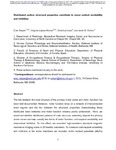Mostrar o rexistro simple do ítem
Distributed cortical structural properties contribute to motor cortical excitability and inhibition
| dc.contributor.author | López-Alonso, Virginia | |
| dc.contributor.author | Dayan, Eran | |
| dc.contributor.author | Liew, Sook Lei | |
| dc.contributor.author | Cohen, Leonardo | |
| dc.date.accessioned | 2024-02-01T18:14:15Z | |
| dc.date.available | 2024-02-01T18:14:15Z | |
| dc.date.issued | 2017-08-19 | |
| dc.identifier.citation | Dayan, E., López-Alonso, V., Liew, SL. et al. (2017). Distributed cortical structural properties contribute to motor cortical excitability and inhibition. bioRxiv. https://doi.org/10.1101/178301 | es_ES |
| dc.identifier.uri | http://hdl.handle.net/2183/35334 | |
| dc.description | The copyright holder for this preprint is the author/funder, who has granted bioRxiv a license to display the preprint in perpetuity. This article is a US Government work. It is not subject to copyright under 17 USC 105 and is also made available for use under a CC0 license. | es_ES |
| dc.description.abstract | [Abstract]: Introducción:The link between the local structure of the primary motor cortex and motor function has been well documented. However, motor function relies on a network of interconnected brain regions and the link between the structural properties characterizing these distributed brain networks and motor function remains poorly understood. Here, we examined whether distributed patterns of brain structure, extending beyond the primary motor cortex can help classify two forms of motor function: corticospinal excitability and intracortical inhibition. To this effect, we recorded high-resolution structural magnetic resonance imaging scans in 25 healthy volunteers. To measure corticospinal excitability and inhibition in the same volunteers we recorded motor evoked potentials (MEPs) elicited by single-pulse transcranial magnetic stimulation (TMS) and short-interval intracortical inhibition (SICI) in a separate session. Support vector machine (SVM) pattern classification was used to identify distributed multivoxel gray matter areas, which distinguished subjects who had lower and higher MEPs and SICIs. We found that MEP and SICI classification could be predicted based on a widely distributed, largely nonoverlapping pattern of voxels in the frontal, parietal, temporal, occipital and cerebellar regions. Thus, structural properties distributed over the brain beyond the primary motor cortex relate to motor function. | es_ES |
| dc.language.iso | eng | es_ES |
| dc.publisher | US Government | es_ES |
| dc.relation.uri | https://doi.org/10.1101/178301 | es_ES |
| dc.rights | CC0 1.0 Universal | es_ES |
| dc.rights.uri | http://creativecommons.org/publicdomain/zero/1.0/ | * |
| dc.subject | Cortical excitability | es_ES |
| dc.subject | Cortical inhibition | es_ES |
| dc.subject | TMS | es_ES |
| dc.subject | MRI | es_ES |
| dc.title | Distributed cortical structural properties contribute to motor cortical excitability and inhibition | es_ES |
| dc.type | info:eu-repo/semantics/preprint | es_ES |
| dc.rights.access | info:eu-repo/semantics/openAccess | es_ES |
| UDC.journalTitle | BioRxiv | es_ES |
Ficheiros no ítem
Este ítem aparece na(s) seguinte(s) colección(s)
-
II - Artigos [546]






